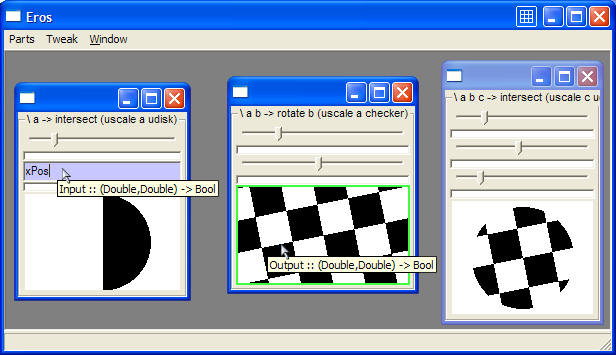30th March 2007, 12:17 pm
Three related software releases. I am very interested in comments and contributions.
TypeCompose provides some classes & instances for forms of type composition. It also includes a very simple implementation of data-driven computation. I factored it out of a new implementation of Phooey.
Phooey is a library for functional user interfaces. Highlights in this 0.3 release:
- Uses new TypeCompose package, which includes a simple implementation of data-driven computation.
- New Applicative functor interface.
- Eliminated the catch-all Phooey.hs module. Now import any one of Graphics.UI.Phooey.{Monad ,Applicative,Arrow}.
- Phooey.Monad has two different styles of output widgets, made by owidget and owidget’. The latter is used to implement Phooey.Applicative.
- Self- and mutually-recursive widgets now work again in Phooey.Monad. They wedge in Phooey.Arrow and Phooey.Applicative.
Phooey is also used in GuiTV, a library for composable interfaces and “tangible values”. I’ve also just updated GuiTV to 0.3, to sync with Phooey 1.0.
Three related software releases. I am very interested in comments and contributions. TypeCompose provides some classes & instances for forms of type composition. It also includes a very simple implementation...
27th March 2007, 11:14 am
Warning: if you’re on the ICFP program committee and want to preserve double-blind reviewing, please ignore this post.
I’ve been working on an ICFP paper called “Tangible Functional Programming”, revising my last year’s submission on Eros. If you’re interested in taking a look, I’d greatly appreciate any comments, especially before the April 6 submission deadline.
Abstract
We present a user-friendly approach to unifying program creation and execution, based on a notion of “tangible values” (TVs), which are visible and interactive GUI manifestations of pure values. Programming happens by gestural composition of TVs. Our goal is to give end-users the ability to create parameterized, composable content without imposing the usual abstract and linguistic working style of programmers. We hope that such a system will put the essence of programming into the hands of many more people, and in particular people with artistic/visual creative style.
In realizing this vision, we develop algebras for visual presentation and for “deep” function application, where function and argument may both be nested within a structure of tuples, functions, etc. Composition gestures are translated into chains of combinators that act simultaneously on statically typed values and their visualizations.
Here is a figure from the paper, showing one stage of an interactively composed interactive 2D region. The user selects compatibly-typed input and output widgets, typically in different TVs. The result is a new TV that merges the source TVs, except for the connected input and output, which vanish. The sliders control the disk and checker sizes and the checker’s rotation angle.

Edit on March 28:I just added two relevant pointers to the paper’s web page:
Warning: if you’re on the ICFP program committee and want to preserve double-blind reviewing, please ignore this post. I’ve been working on an ICFP paper called “Tangible Functional Programming”, revising...
